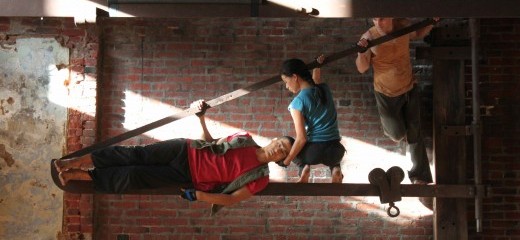
Photo: Michael Bartmann
Spirits in an Industrial Space
by Jonathan Stein
Site specific performance succeeds when it attains an ineffable synchronicity with the history, texture and ambiance of a place far from the proscenium stage. Leah Stein’s most recent creation for the 2012 Philly Fringe, Hoist, not only amply succeeds but additionally delivers an emotional intensity that only rapturous movement and imagery can.
The MAAS building site in Northern Liberties was once a brewery and then was converted into a trolley repair garage for the Girard Street Trolley. For Leah Stein, who for two decades has choreographed across acres of Bartram Gardens and the Manayunk Canal, or in the cavernous interiors of the Girard College Chapel and the Rotunda, this might have been one of her smallest sites (although not unlike the intimate spaces of the Edinburgh dance center where I saw her In Situ win a Herald Angel Award in the Fringe Festival there in 2001). The MAAS site was an approximately 40 by 60 foot rectangular room with bare brick walls, a western glass exposure to a setting sun, and a high ceiling of heavy wooden cross beams and trusses, presumably for the suspension of trolley cars a full floor below. The audience moved twice during the hour-long performance, enabling them to share the feeling of heightened consciousness of the space that the four dancers visibly manifested.
The dance was an homage to the architecture of this workplace as well as to the long-gone labors of its workmen and machinery. Michelle Tantoco traversed the space early on with outstretched, angular limbs marking its architecture. Stein, a dozen feet above her in the ceiling trusses, followed Tantoco’s lateral movement, sliding across and hanging from the lines of wooden beams above her fellow dancer.
Tantoco emerged later in a backward suspension, supported by David Konyck and Jung Woong Kim and then began walking sideways across a wall (bringing to mind an earlier Trisha Brown work). With Konyck’s and Kim’s continuing support, Tantoco (and later Kim) walked upside down across the underside of a beam from which trolleys might have hung. All three dancers in a row, grasping the same beam, suspended their torsos vertically, while raising their legs to perpendicular. Linking their torsos with their feet ignited a forward and back locomotion—a droll reminiscence of past vehicular motion.
The constant presence of the weightedness of bodies in Hoist, either in motion or at rest, was for me the strongest metaphorical connection to an industrial past where physical labor and heavy machinery predominated. We saw the dancers in challenging suspensions and swings off the ceiling beams; in streams of lifts and carries that had a seamless continuity to them; the bodies of Stein and Kim in equibalance at the midriff on beams one above the other. The frequent presence of bodies at rest, seated or laid high across ceiling timbers, seemed like that of distant spirits visiting a space of reconsecrated activity.
The company’s authentic embrace of weightedness also recognized, and with irony, the limits of the gravity-defying movement that often defines dance. When Konyck and Kim each in turn lay grounded on their sides, movement was reduced to pushing or dragging their bodies along the ground as though they were unwieldly lumps of factory waste.
Playful but focused throughout, in-the-moment improvisation brought a leveling quality to the intensity of the work-effort of the dance. The strictures of the architecture and highly athletic interactions with the industrial space dissipated in the face of Tantoco, Konyck and Kim’s physical antics that added comedy to the mix. (The humor was especially appreciated in the vocal responses of a half dozen young children at a 4 p.m. showing.) The unexpected vocalizing of the dancers, and the cello improvisations of Eric Coyne, spun our minds into other worlds. Early in the dance, humming by the performers was deftly joined by an out of sight solo cello to become a chant-like benediction. Offstage bird and later cricket-like sounds, puffs and pops, and Samurai-like shrieks from Kim offered sonic surprises throughout the show.
An especially strong and memorable third and last segment of the piece brought Kim to a small section of a wall with a fading white and blue mosaic. There he performed a solo in the setting, lasered sunlight of the 4 o’clock performance, and later, in the shadows of the sunset in the evening performance (which I also saw). Kim used one finger to explore and scratch its way across this wall and percussively struck his back with accompanying thuds into the wall. To cap off the last performance he dislodged chunks of plaster and stone, filling the silence with their falls onto the wooden floor, and layered the decay with a feeling of danger and active destruction. Then, at the slowest of speeds, his head and hand pushed into rotation the rusted iron triangular arm of a crane attached to the wall (the “hoist”?). The image of body and machine joined in slow, synchronous motion, was mesmerizing, like Chaplin and his wrench wedded to his machine’s bolts.
This triangular crane arm soon became the platform for a host of inventive play by all the dancers. At one memorable point, Kim lay on his side along the horizontal arm of the crane with Tantocco cupping his head and Konyck propelling the crane by pushing with one extended leg onto the wall. This image echoed the classical geometries of a Michelangelo Pieta.
In a darkening space, the four dancers ended their piece with high energy swings suspended from one beam. Finally they stood quietly facing us in the shadows, each, including the cellist, with two discarded, rusted iron ties from railroad tracks. The concluding clanging metallic sounds they made was the music of bells, consecrating a space that had become blessed by this performance.
Hoist, Leah Stein Dance Company, Sept. 19-23, MAAS Building.
By Jonathan Stein
September 25, 2012

